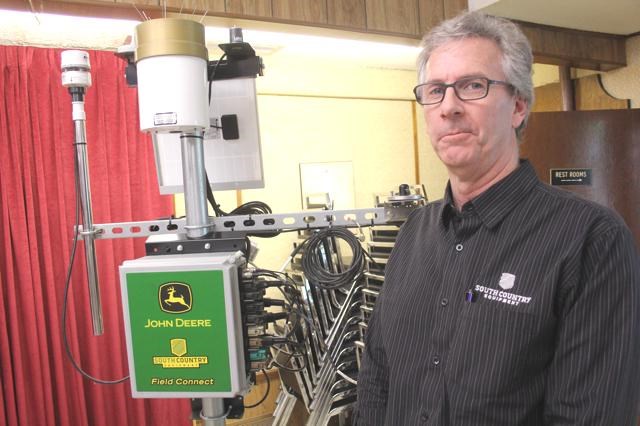By Greg Nikkel
Advancements in computer technology and in other areas are making their effects known on the farm in ways that could scarcely be imagined even a few years ago, including a tripod-mounted weather and sensor station set up in front of the hall of the Rotary Club, as guest speaker Drew Watson explained some of the recent developments that farmers are now using.
Watson is a partner and owner of South Country Equipment, a John Deere dealership, and the unit he set up for display is a John Deere Field Connect unit, which as he explained, can sense everything from weather conditions (such as wind, humidity and temperature) to the moisture in the soil down to 4.5 feet and development stage and moisture level of the crops in the field where it is situated.
The data collected is then transmitted directly to the producer, who can monitor how his field is doing on a continuous basis.
This was just one example of some of the technology being developed and is now in use by farmers of all kinds, said Watson. “The changes have been so huge in the last five years, we didn’t see what this was going to look like.”
He showed a short video made in 2013, showing a farmer sitting at his desk and using a projected computer screen that could connect to all aspects of production, and with suppliers, at a touch of the screen. Watson said they are now capable of doing about 90 per cent of what was shown in that video.
Part of what they are currently putting in place, he said, is that about 800 pieces of equipment can all be tracked as to how they are operating with precision. It is so precise that customers can be called ahead of time to warn them that a problem is about to occur. “We have done this from the Weyburn store,” said Watson, relating how one customer was about to call the dealership about a piece of equipment, but he was called first by the dealership about a problem about to occur.
Explaining how the field connect unit works, Watson noted they have 104 units, and many producers and even agronomists are using them, even farmers who have no green-coloured equipment on their farms.
The data is such that an agronomist can look at it and let the customer if, for example, they should be out spraying for insects or fungal diseases. One time a customer was contacted about this, and the farmer said his father was at that moment fuelling up to go out spraying, and was amazed that the agronomist could know that.
Watson noted one agronomist in Mossbank has three of the units, and said of the information collected, “The respect for data is huge. We’ll only look at it if they want us to. The data is stored in the cloud, and they can share it with their banker or with an agronomist if they want.”
“I like showing this stuff to young people, because they get excited about it,” said Watson, noting they have programs that can even monitor how much grain a combine is processing and what its fuel consumption, with recommendations of adjusting settings to make its performance optimal. Adjustments can be made by a producer sitting in his truck with an iPad, said Watson.
“I do a lot of work with the Ministry of Agriculture, and promote careers in agriculture, getting young people to see what the opportunities are,” he said, noting there are actually more ag jobs available in Saskatchewan than in the oil sector.
“We can compete anywhere in the world, we know that,” he said.
Asked how small a farm can be to survive or to use this technology, Watson replied, “This is something we deal with every day,” adding that there is one single answer to that question.
“So many people we deal with are still family farms. We are a family business. True, there are some farms are 35,000 acres, but they can support three or four families. You see the complexities of how farms are run. You have to respect all the different ways of doing it.”
Asked if drones can be used by farmers in their farm operations, he said there are uses for drones, but they have needed to develop longer-lasting batteries to make it worth it, noting the first two drones they had “went back in a bag” because they ran out of power and crashed.
“It’s better now with longer battery life, that can do a quarter section at a time,” he said, as they fly over fields and can collect about how crops are doing.
Asked if their equipment is compatible with other brands, Watson noted that most other farm equipment companies are able to patch in to their systems, with the exception of Bourgeault equipment.
The technology advancements are such that some university ag professors are unaware of how far its gone, said Watson, noting he was at the University of Saskatchewan for an ag career day. “I was shocked that a number of professors who walked up to me and pointed to the Field Connect unit and asked what it was.”
He pointed out that the head agronomist for all of Canada asked him to be a keynote speaker for their national convention to talk about the technological advances that are being made, and he pointed to a John Deere software expert instead who was able to attend and talk to the convention.




